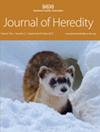A genome assembly for the Chryxus Arctic (Oeneis chryxus), the highest butterfly in North America
IF 2.5
2区 生物学
Q2 EVOLUTIONARY BIOLOGY
引用次数: 0
Abstract
We describe a highly contiguous and complete diploid genome assembly for the Chryxus Arctic, Oeneis chryxus (E. Doubleday, [1849]), a butterfly species complex spanning much of northern and western North America. One subspecies, the Ivallda Arctic (O. c. ivallda), is endemic to California’s Sierra Nevada and of particular biogeographic interest and conservation concern. Extreme alpine habitats occupied by this subspecies include the summit of Mt. Whitney, California, representing the highest elevation butterfly population in North America. The assembly presented here consists of two haplotypes, 738.92 and 770.85 Mb in length, with contig N50 values of 10.49 and 10.13 Mb, scaffold N50 values of 25.35 and 25.69 Mb, scaffold L50 values of 13 and 14, and BUSCO completeness scores of 96.5 and 98.3%, respectively. More than 97% of the assembly is organized into 29 scaffolds, which likely represent whole chromosomes. This assembly is the first major genomic resource for Oeneis, providing a foundational reference for future genomic studies on the taxonomy, evolutionary history, and conservation of the genus. As part of the California Conservation Genomics Project, we will use this assembly in conjunction with short-read resequencing to resolve patterns of evolutionary differentiation, adaptive genomic variation, and gene flow among remaining O. c. ivallda populations. These data can and will be used to inform the subspecies’ conservation as warming climatic conditions continue to lead to the loss and fragmentation of alpine habitats. We also provide genome assemblies for the O. chryxus mitochondrion and a Wolbachia endosymbiont.北美洲最高蝶类北极蝶(Oeneis chryxus)的基因组组装
我们描述了北极蝶(Oeneis chryxus (E. Doubleday, [1849])的一个高度连续和完整的二倍体基因组。其中一个亚种--伊瓦尔达北极蝶(O. c. ivallda)--是加利福尼亚内华达山脉的特有种,具有特别的生物地理学意义和保护意义。该亚种占据的极端高山栖息地包括加利福尼亚惠特尼山山顶,代表了北美海拔最高的蝴蝶种群。本文介绍的组合包括两个单倍型,长度分别为 738.92 和 770.85 Mb,contig N50 值分别为 10.49 和 10.13 Mb,scaffold N50 值分别为 25.35 和 25.69 Mb,scaffold L50 值分别为 13 和 14,BUSCO 完整性得分分别为 96.5 和 98.3%。超过 97% 的组装结果被组织到 29 个支架中,这些支架可能代表了整条染色体。该汇编是烯丙基蝶形花属(Oeneis)的第一个重要基因组资源,为今后有关该属的分类、进化史和保护的基因组研究提供了基础参考。作为加利福尼亚保护基因组学项目的一部分,我们将结合短线程重测序来使用该组合,以确定进化分化模式、适应性基因组变异以及剩余 O. c. ivallda 种群之间的基因流。随着气候条件不断变暖,高山栖息地不断消失和破碎化,这些数据将用于亚种的保护。我们还提供了 O. chryxus 线粒体和 Wolbachia 内共生体的基因组组装。
本文章由计算机程序翻译,如有差异,请以英文原文为准。
求助全文
约1分钟内获得全文
求助全文
来源期刊

Journal of Heredity
生物-遗传学
CiteScore
5.20
自引率
6.50%
发文量
63
审稿时长
6-12 weeks
期刊介绍:
Over the last 100 years, the Journal of Heredity has established and maintained a tradition of scholarly excellence in the publication of genetics research. Virtually every major figure in the field has contributed to the journal.
Established in 1903, Journal of Heredity covers organismal genetics across a wide range of disciplines and taxa. Articles include such rapidly advancing fields as conservation genetics of endangered species, population structure and phylogeography, molecular evolution and speciation, molecular genetics of disease resistance in plants and animals, genetic biodiversity and relevant computer programs.
 求助内容:
求助内容: 应助结果提醒方式:
应助结果提醒方式:


